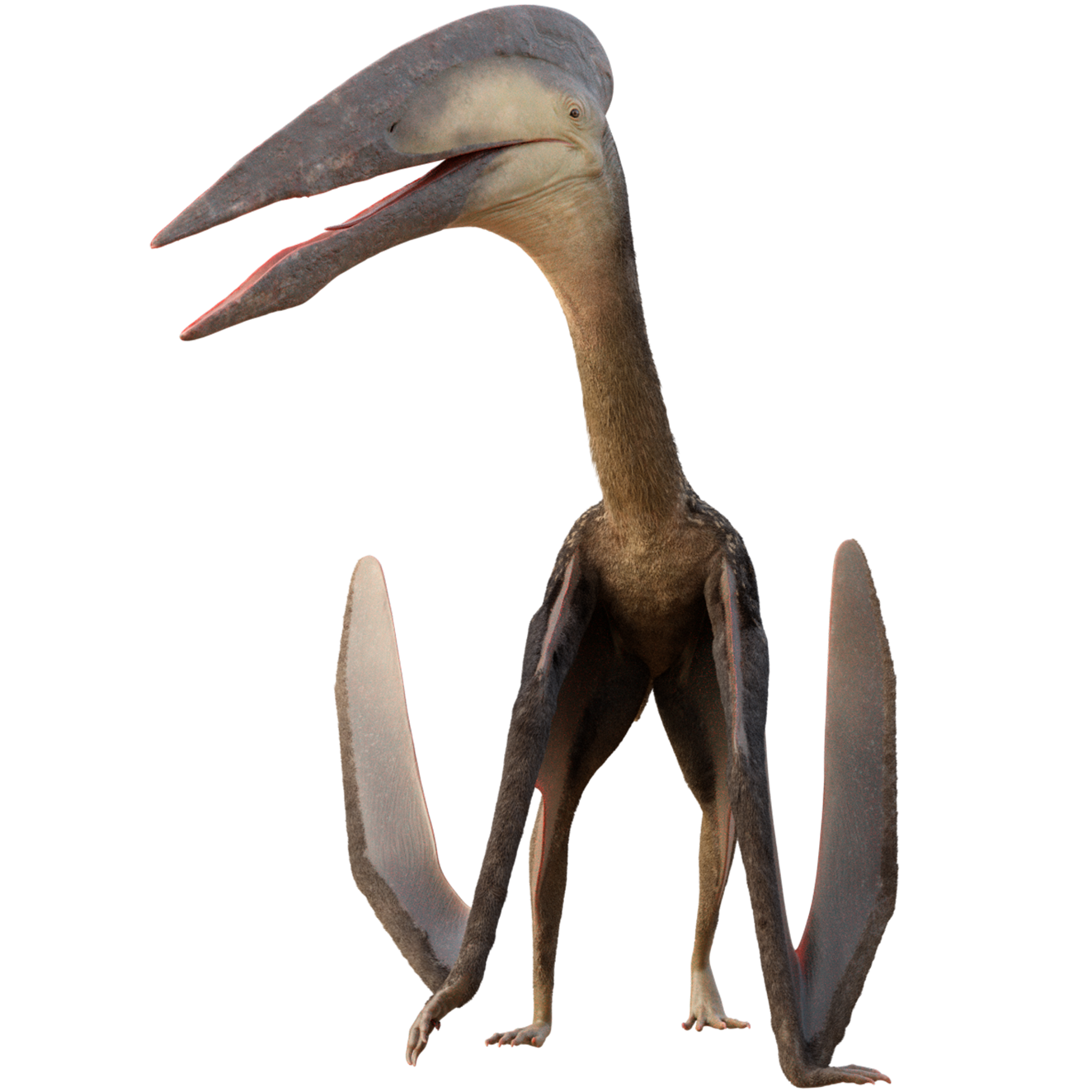The Dragon of Hateg Isle
This giraffe-sized pterosaur terror was the apex predator of an island ecosystem free of large carnivorous dinosaurs, in a region which would one day become famous for the stories of Dracula!
Overview: Here there be dragons. Today, we associate the Romanian region of Transylvania with stories of Dracula, but 66 million years ago, it wasn't Dracula that terrorized Transylvania, but a different winged beast, essentially a dragon, the giant pterosaur Hatzegopteryx. This creature, discovered in the late 20th Century, was the apex predator of a strange island ecosystem free of large theropods, in which pterosaurs ruled supreme. If not the largest, Hatzegopteryx was arguably the most fearsome of all pterosaurs, and the dwarf dinosaurs of its island habitat would have looked to the skies in fear of the Dragon of Hateg Island.
Discovery: Hatzegopteryx thambema was discovered in the late 1970s in the Densuş Ciula Formation of the Hateg Basin near the village of Vălioara, Transylvania, Romania. In 2002, it was named by French paleontologist Eric Buffetaut and Romanian paleontologists Dan Grigorescu and Zoltan Csiki. Hatzegopteryx means “Hateg wing”, derived from Hatzeg (Hateg), the name of the basin in which it was found, and the Greek word “pteryx” meaning “wing”. The species name thambema is also Greek, meaning “terror” or “monster”, so named for its large size. So taken all together, its name could be translated as “Winged Terror of Hateg”. The holotype (original) specimen consists of parts of the skull and a humerus. Additional material has been recovered from the Densuş Ciula Formation as well as two other formations from the Hateg Basin, the Sânpetru Formation and the Sebeș Formation.
Evolution and Description: Hatzegopteryx was one of the last of the pterosaurs, in a family of large, short-tailed, toothless pterosaurs call Azhdarchidae, which also includes the giant North American Quetzalcoatlus. Azhdarchids were large, and had long legs, long necks, and huge heads with spear-like jaws. Unlike pteranodonts, which were primarily piscivores (fish-eaters), azhdarchids were aerial predators of terrestrial prey, like giant storks. Hatzegopteryx was one of the largest of the azhdarchids, and pterosaurs in general. The only one that may have been larger was Quetzalcoatlus. However, Hatzegopteryx was more robustly built with a shorter neck and a more robust skull and beak. Its skull was huge, estimated at least 1.6 meters (5.25 ft) and possibly as much as 2.5 meters (8.2 ft) long! The skull bones were stout and robust, with ridges for strong muscle attachments. And its wingspan is estimated to have been 10 to 12 meters (33 to 39 ft), the size of a small aircraft. Like other pterosaurs, its wing consisted of a forelimb with an extremely long finger, with a membrane stretched between the finger and its body. It is a wing design outwardly similar to bats, except whereas bats include all five fingers into the wing, pterosaurs included only one. And like bats, when walking on the ground, pterosaurs used their folded wings as front legs. The long legs and neck of Hatzegopteryx allowed it to stand very tall and would have made it more efficient at walking on the ground than non-azhdarchid pterosaurs.
Ecology: 66 million years ago, at the end of the Cretaceous, Transylvania was an island in the legendary Tethys Sea, called Hateg Island. This island was home to dwarf versions of mainland dinosaurs, including the dwarf titanosaurian sauropod Magyarosaurus, the dwarf hadrosaur Telmatosaurus, the iguanodont Zalmoxes, and the dwarf nodosaurid ankylosaur Struthiosaurus. All these herbivores are about half the length of their mainland counterparts, having shrunk due to insular dwarfism, a process by which animals tend to grow smaller on islands as an adaptation to limited space and food. While small, birdlike predators, like the possible dromaeosaur Balaur, were present, Hateg Island was notably missing any apex theropods. This left the apex predator niche open for the pterosaurs, and fill it Hatzegopteryx did. Azhdarchids are thought to have hunted much like giant storks, targeting terrestrial prey which they killed and consumed with their large stork-like beaks. But Hatzegopteryx took this lifestyle to the extreme, taking not only bite sized prey, but even killing animals too large to swallow whole, which is saying something given the size of its beak and the fact that it had a very wide gape. And with no other predators to challenge it, Hatzegopteryx ruled supreme as lord of both land and sky, the terror of Late Cretaceous Transylvania.
Extinction: Hatzegopteryx lived at the end of the Cretaceous, which means it would have perished as part of the Cretaceous-Paleogene Extinction, which was caused by an asteroid twice the size of Mt. Everest colliding with the Gulf of Mexico. While the impact was far from Europe, the global firestorm and subsequent “nuclear winter” spelled the doom for the Dragons of Hateg Island. Never again would an aerial predator rule an ecosystem so supremely. A life reconstruction of Hatzegopteryx can be seen at the Dino Parc Rasnov in Rasnov, Romania. The closely related and similarly sized azhdarchid Quetzalcoatlus can be seen at the Field Museum of Natural History in Chicago, Illinois, USA, and at the Arizona Museum of Natural History, in Mesa, Arizona, USA. Hatzegopteryx features prominently in the 2022-2023 BBC documentary Prehistoric Planet.
Hatzegopteryx FAQ
Hatzegopteryx size / How big was Hatzegopteryx?
See height, weight, and length.
Hatzegopteryx wingspan
Hatzegopteryx had a wingspan of 10-12 m (33-39 ft), one of the largest creatures to ever fly!
Hatzegopteryx weight / How much did Hatzegopteryx weigh?
Hatzegopteryx probably only weighed about 300 kg (661 lbs), rather light for an animal the size of a small aircraft!
How tall was Hatzegopteryx?
Hatzegopteryx was about 4.6 m (15 ft) tall, similar in height to a modern giraffe!
What did Hatzegopteryx eat?
Hatzegopteryx was an apex predator, preying upon terrestrial vertebrates, including dinosaurs!
What is Hatzegopteryx’s closest living relative?
Like all pterosaurs, the closest living relatives of Hatzegopteryx are the birds, since birds are dinosaurs, and pterosaurs are closely related to the dinosaurs in the clade Avemetatarsalia. Crocodilians, while not avemetatarsalians, are members of the larger clade Archosauria, which also includes avemetatarsalians, thus crocodilians are also cousins of the pterosaurs, albeit more distant than birds.
Hatzegopteryx family members / Hatzegopteryx family / What kind of animal was Hatzegopteryx?
Hatzegopteryx was a type of pterosaur (flying reptile) in the family Azhdarchidae, known for being large predators of terrestrial prey. The American genus Quetzalcoatlus was a close relative of Hatzegopteryx.
Where did Hatzegopteryx live? / Where was Hatzegopteryx found?
Hatzegopteryx lived in an island environment in what is now the Hateg Basin of Transylvania, Romania.
When did Hatzegopteryx live?
Hatzegopteryx lived about 66 million years ago at the end of the Cretaceous Period.
What does Hatzegopteryx mean? / Hatzegopteryx name meaning
Hatzegopteryx means “Hateg Wing”, named for the Hateg Basin where it was found.

